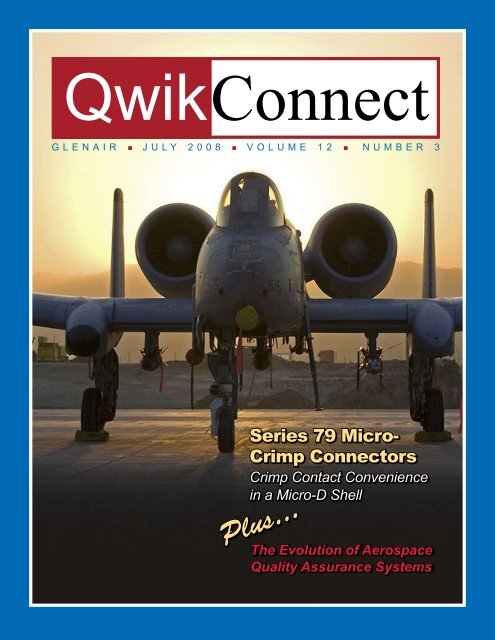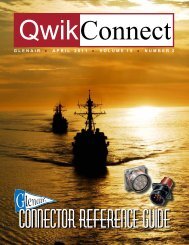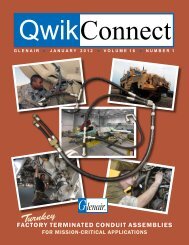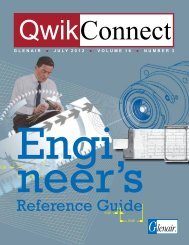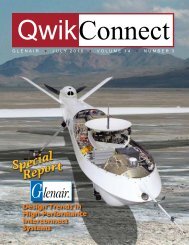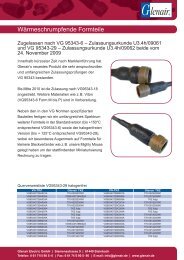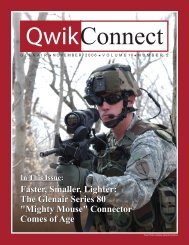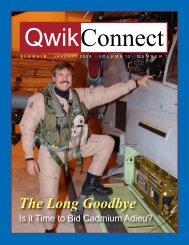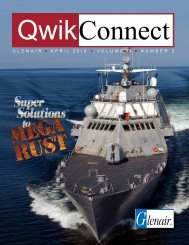July 2008 - Glenair, Inc.
July 2008 - Glenair, Inc.
July 2008 - Glenair, Inc.
You also want an ePaper? Increase the reach of your titles
YUMPU automatically turns print PDFs into web optimized ePapers that Google loves.
QwikConnect<br />
GLENAIR n JULY <strong>2008</strong> n VOLUME 12 n NUMBER 3<br />
Series 79 Micro-<br />
Crimp Connectors<br />
Crimp Contact Convenience<br />
in a Micro-D Shell<br />
Plus... Plus...<br />
The Evolution of Aerospace<br />
Quality Assurance Systems
Crimp-and-Poke Comes<br />
to the MIL-DTL-83513<br />
Micro-D Connector<br />
Attaching wires to contacts with solder is a<br />
standard practice in the interconnect industry.<br />
Solder termination has several advantages,<br />
including that it can be accomplished without the use<br />
of highly-specialized tools. But solder terminations<br />
are difficult to perform in the field when a connector<br />
requires modification or repair. Likewise, connectors<br />
equipped with pre-terminated wire pigtails—typically<br />
molded in place or potted at the factory with a plastic<br />
sealant—are challenging to work with in applications<br />
where field repairability and ease-of-assembly are<br />
required.<br />
For these reasons,<br />
crimp style contacts<br />
(which marry the<br />
conductor<br />
to the<br />
contact<br />
with<br />
controlled<br />
compression<br />
applied with a<br />
specialized crimp tool<br />
and die) are preferred in<br />
many military, aerospace,<br />
industrial and rail applications.<br />
Crimp contacts, which can be inserted and removed<br />
multiple times from the connector, allow for contact<br />
replacement or circuit changes with little difficulty<br />
compared to solder or mold-in-place contacts.<br />
Military standard type connectors, such as<br />
the ubiquitous D38999, utilize a four indent crimp<br />
contact termination system which affords uniform<br />
displacement of both the wire conductor and the<br />
contact material. Upon completion, the wire strands<br />
and contact material are formed together in a<br />
solid mass with a minimum of voids and little or no<br />
extrusion of the wire strands.<br />
In a well performed crimp joint, the metal flow<br />
of the malleable gold-plated copper contact and<br />
the copper wire conductor essentially form a cold<br />
2<br />
QwikConnect<br />
weld. The mechanical strength of the cold weld joint<br />
is outstanding, as is its electrical continuity. In pull<br />
tests, the wire conductor will separate long before<br />
the wire would pull away from the crimp joint.<br />
Because of the different environments in<br />
which electrical connectors are deployed, there are<br />
situations in which solder and/or pigtail assemblies<br />
are perfectly acceptable or are in fact preferred over<br />
crimp. <strong>Glenair</strong>’s MIL-DTL-83513 qualified connector<br />
series is a perfect example. In fact, this TwistPin<br />
equipped Micro-D is the preferred interconnect in<br />
missile systems and other miniaturized<br />
applications that do not require the<br />
versatility of a crimp contact system.<br />
These are<br />
typically “install<br />
and forget” applications<br />
that are not subject to<br />
repeated mating cycles or postproduction<br />
modifications.<br />
But other applications,<br />
for example modular<br />
avionic systems,<br />
are more suited<br />
to crimp contact<br />
systems. But<br />
unfortunately,<br />
there have<br />
been few good<br />
choices when it comes to rectangular,<br />
D-shaped connectors used in miniaturized rack-andpanel<br />
or module-to-chassis applications. Until Now!<br />
QwikConnect is proud to introduce a versatile<br />
new crimp-contact connector series: the Series<br />
79 Micro-Crimp from <strong>Glenair</strong> is the perfect choice<br />
for applications which require the convenience<br />
of a hybrid crimp contact system in a Micro-D<br />
Subminiature package. The following pages present<br />
a short overview of the “Micro-Crimp” including<br />
connector architecture, accessories, and layouts.<br />
For ordering information and other product details,<br />
a “sneak-peak” of the new draft catalog has been<br />
posted at www.glenair.com. The Series 79 connector<br />
is available now and ready for deployment in rugged<br />
applications that require small size and weight,<br />
environmental sealing, improved shielding and, most<br />
importantly, the convenience of industry-standard<br />
crimp-and-poke signal, power and coax contacts.<br />
QwikConnect n <strong>July</strong> <strong>2008</strong>
<strong>Glenair</strong>’s <strong>Glenair</strong>’s Series Series 79 Micro-Crimp<br />
Micro-Crimp<br />
Connectors Connectors and Cables: Cables:<br />
The Micro-D Micro-D Connector Connector with<br />
Crimp Crimp Power, Power, Signal Signal<br />
and Coax Contacts Contacts<br />
Today's defense/aerospace systems require advanced levels of environmental protection,<br />
electromagnetic shielding and size/weight reduction. The Series 79 Micro-Crimp connector was created<br />
to meet the need for environmental sealing, improved shielding, and reduced size/weight. Available in<br />
a wide range of insert arrangements, the Micro-Crimp offers size #12, #16 and #23 contacts. Snap-in rear<br />
release signal, power and coaxial contacts meet the requirements of SAE AS39029. Printed circuit board<br />
versions complete the product range.<br />
Crimp, Rear-Release<br />
AS39029 type contacts in size<br />
#12, #16 and #23.<br />
Machined<br />
Aluminum<br />
Shell<br />
Fluorosilicone<br />
Grommet<br />
MICRO-CRIMP RECEPTACLE<br />
QwikConnect n·<br />
<strong>July</strong> <strong>2008</strong><br />
Plug With Socket Contacts<br />
30% Glass-Filled<br />
LCP Insulators<br />
360° EMI Spring<br />
Innovative spring assures excellent<br />
shielding performance.<br />
Three Contact Sizes:<br />
12, 16 and 23<br />
Fluorosilicone<br />
Interfacial Seal<br />
Receptacle With Pin Contacts<br />
EMI Spring<br />
Environmentally Sealed<br />
Fluid-resistant gaskets and seals provide<br />
IP67 ingress protection.<br />
Gold-plated BeCu<br />
Contact with SST<br />
Hood<br />
BeCu Insert<br />
Retention Clip<br />
RTV Sealing<br />
MICRO-CRIMP PLUG<br />
Fluorosilicone<br />
Grommet<br />
3
Lightweight, low profile shielding adapters allow<br />
direct attachment of cable shields for excellent EMI<br />
performance. These two-piece adapters lock into a<br />
groove on the connector body.<br />
Used for pitot tube sensors on aircraft, these stainless<br />
steel pneumatic contacts are airtight up to 100 p.s.i. Fits<br />
size #12 contact cavities.<br />
4<br />
Panel<br />
Gasket<br />
EMI AdAPTERS<br />
PnEUMATIC COnTACTS<br />
PRInTEd CIRCUIT BOARd<br />
Epoxy<br />
Encapsulant<br />
QwikConnect<br />
Series 79 Micro-Crimp Options and Accessories<br />
BLInd MATE COnnECTORS<br />
Micro-Crimp panel mount connectors are ideal for<br />
module-to-chassis packaging. Stainless steel guide pins<br />
assure connector alignment for blind mate applications.<br />
Float bushings are also available.<br />
EMI SPRInG<br />
The EMI springs utilized on <strong>Glenair</strong> Micro-Crimp plug<br />
connectors provide 360° of contact with the mating<br />
connector. The closely spaced spring coils reduce EMI<br />
apertures to a minimum.<br />
PAnEL GASkET<br />
Panel mount Micro-Crimp connectors are furnished<br />
with gaskets made from Chomerics CHO-SEAL 1287<br />
fluorosilicone filled with silver-plated aluminum for low<br />
resistivity and excellent resistance to avionics fluids.<br />
QwikConnect n <strong>July</strong> <strong>2008</strong>
Shell<br />
Size<br />
Insert<br />
Arr.<br />
QwikConnect n·<br />
<strong>July</strong> <strong>2008</strong><br />
SERIES 79 MICRO-CRIMP InSERT ARRAnGEMEnTS<br />
no. of Contacts and<br />
Contact Size Mating Face Pin Connector<br />
A A-5 5 #23 CONTACTS<br />
B<br />
B-2P2<br />
B-2w2<br />
2 #16 CONTACTS<br />
B B-9 9 #23 CONTACTS<br />
C C-13 13 #23 CONTACTS<br />
D D-15 15 #23 CONTACTS<br />
D<br />
D<br />
E<br />
D-3P3<br />
D-3w3<br />
D-7P2<br />
D-7w2<br />
E-11P2<br />
E-11w2<br />
3 #16 CONTACTS<br />
5 #23 CONTACTS<br />
2 #16 CONTACTS<br />
E E-19 19 #23 CONTACTS<br />
E E-7P3<br />
F<br />
F-15P2<br />
F-15w2<br />
1<br />
1 2 3<br />
4 5<br />
A1 A2<br />
2 3 4 5<br />
6 7 8 9<br />
1 2 3 4 5<br />
6 7<br />
8 9 10 11 12 13<br />
1 2 3 4 5<br />
6 7 8<br />
9 10 11 12 13 14 15<br />
A1 A2<br />
A3<br />
A1 1 2 3<br />
A2<br />
4 5<br />
9 #23 CONTACTS<br />
2 #16 CONTACTS 5 6 7 8 9<br />
4 #23 CONTACTS<br />
3 #16 CONTACTS<br />
13 #23 CONTACTS<br />
2 #16 CONTACTS<br />
F F-23 23 #23 CONTACTS<br />
F<br />
F-5P5<br />
F-5w5<br />
5 #16 CONTACTS<br />
G G-33 33 #23 CONTACTS<br />
A1<br />
A1 1 2 3 4<br />
A2<br />
1 2 3 4 5 6 7 8 9 10<br />
11 12 13 14 15 16 17 18 19<br />
1 A1 A2 A3<br />
2<br />
3<br />
7<br />
1 2 3 4 5<br />
13<br />
1 2 3 4 5<br />
8 9 10 11 12 13<br />
6<br />
7<br />
6<br />
A2<br />
4<br />
8 9 10 11 12<br />
14 15 16 17 18 19 20 21 22 23<br />
A1 A2 A3 A4 A5<br />
1 2 3 4 5 6 7 8 9 10 11 12<br />
13 23<br />
24 25 26 27 28 29 30 31<br />
32 33<br />
5
6<br />
Shell<br />
Size<br />
H<br />
Insert<br />
Arr.<br />
H-10P4<br />
H-10w4<br />
H H-29P7<br />
H<br />
H<br />
H<br />
H-36P2<br />
H-36w2<br />
H-54P2<br />
H-54w2<br />
H-5P5<br />
H-5w5<br />
SERIES 79 MICRO-CRIMP InSERT ARRAnGEMEnTS<br />
no. of Contacts and<br />
Contact Size Mating Face Pin Connector<br />
6 #23 CONTACTS<br />
4 #12 CONTACTS<br />
22 #23 CONTACTS<br />
7 #16 CONTACTS<br />
34 #23 CONTACTS<br />
2 #12 CONTACTS<br />
52 #23 CONTACTS<br />
2 #16 CONTACTS<br />
5 #12 CONTACTS<br />
H H-66 66 #23 CONTACTS<br />
J<br />
J<br />
J-17P4<br />
J-17w4<br />
J-25P2<br />
J-25w2<br />
13 #23 CONTACTS<br />
4 #16 CONTACTS<br />
23 #23 CONTACTS<br />
2 #16 CONTACTS<br />
J J-33 33 #23 CONTACTS<br />
1<br />
A1<br />
17<br />
34<br />
1 2<br />
A1 A2<br />
3<br />
A3 A4<br />
4 5<br />
A1 A2 A3 A4 A5 A6 A7<br />
6<br />
2 3 5 6 8 9 11 12 14 15 17 18 20 21<br />
4<br />
7<br />
10<br />
1 2 3 4 5 6 7 8<br />
A1<br />
9<br />
A2<br />
17<br />
13<br />
16<br />
18 25<br />
26 27 28 29 30 31 32 33 34<br />
1 2 3 4 5 6 7 8 9 10 11 12 13 14<br />
15<br />
28<br />
40 41 42 43 44 45 46 47 48 49 50 51 52<br />
A1 A2<br />
A3 A4 A5<br />
19<br />
27<br />
39<br />
1 2 3 4 5 6 7 8 9 10 11 12 13 14 15 16<br />
50 51 52 53 54 55 56 57 58 59 60 61 62 63 64 65 66<br />
A1 A2 1 2 3 4 5 6 7 A3 A4<br />
A1<br />
1 2 3 4 5<br />
13<br />
QwikConnect<br />
8 9 10 11 12<br />
6<br />
7<br />
13<br />
8 9 10 11 12<br />
14 15 16 17 18 19 20 21 22 23<br />
1 2 3 4 5 6 7 8 9 10 11 12 13 14 15 16 17<br />
18 19 20 21 22 23 24 25 26 27 28 29 30 31 32 33<br />
22<br />
A2<br />
33<br />
49<br />
A2<br />
QwikConnect n <strong>July</strong> <strong>2008</strong>
Shell<br />
Size<br />
J<br />
k<br />
k<br />
Insert<br />
Arr.<br />
J-7P7<br />
J-7w7<br />
k-27P4<br />
k-27w4<br />
k-35P2<br />
k-35w2<br />
QwikConnect n·<br />
<strong>July</strong> <strong>2008</strong><br />
SERIES 79 MICRO-CRIMP InSERT ARRAnGEMEnTS<br />
no. of Contacts and<br />
Contact Size Mating Face Pin Connector<br />
7 #16 CONTACTS<br />
23 #23 CONTACTS<br />
4 #16 CONTACTS<br />
33 #23 CONTACTS<br />
2 #16 CONTACTS<br />
k k-43 43 #23 CONTACTS<br />
k<br />
L<br />
k-9P9<br />
k-9w9<br />
L-6P6<br />
L-6w6<br />
Shell<br />
Size<br />
9 #16 CONTACTS<br />
6 #12 CONTACTS<br />
Total<br />
number<br />
of Contact<br />
Positions<br />
W - Size #12 and<br />
#16 Contacts Are<br />
Purchased Separately.<br />
P - Connector Supplied<br />
With All Contacts<br />
<strong>Inc</strong>luding Size 12<br />
and SIze #16 Power<br />
Contacts<br />
F – 15 W 2<br />
number<br />
of Power/<br />
Coaxial<br />
Contact<br />
Positions<br />
A1<br />
A1 A2 A3 A4 A5 A6 A7<br />
A1 A2 1 2 3 4 5 6 7<br />
13<br />
8 9 10 11 12<br />
14 15 16 17 18 19 20 21 22 23<br />
1 2 3 4 5 6 7 8 9 10 11 12 13 14 15 16 17<br />
18 19 20 21 22 23 24 25 26 27 28 29 30 31 32 33<br />
A3 A4<br />
1 2 3 4 5 6 7 8 9 10 11 12 13 14 15 16 17 18 19 20 21 22<br />
23 24 25 26 27 28 29 30 31 32 33 34 35 36 37 38 39 40 41 42 43<br />
A1 A2 A3 A4 A5 A6 A7 A8 A9<br />
A1 A2<br />
A3 A4 A5 A6<br />
Insert Arrangements<br />
Explained<br />
The first letter represents the shell size. The<br />
number following the shell size represents<br />
the total number of contacts. If the insert<br />
arrangement is a mixed layout with signal<br />
contacts and coaxial/power contacts, the<br />
letter "W" specifies the connector to be<br />
furnished with signal contacts only (coax/<br />
power contacts purchased separately),<br />
and the letter "P" specifies the connector<br />
to be furnished with both signal and power<br />
contacts. For complete order information,<br />
please visit www.glenair.com.<br />
A2<br />
7
Funny Pages<br />
QwikConnect<br />
Guaranteed to Please:<br />
Recently a US-based company presented a<br />
Japanese manufacturer with a new quality<br />
assurance requirement for one of their highvolume<br />
products. In the purchase order, the<br />
customer specified they will accept three<br />
defective parts per 10,000. Dutifully, the<br />
Japanese supplier produced and shipped 10,000<br />
good parts—and in a separate delivery sent the<br />
customer three bad ones.<br />
The Quotable Groucho Marx:<br />
Outside of a dog, a book is man’s best friend.<br />
Inside of a dog, it’s too dark to read.<br />
Time flies like an arrow. Fruit flies like a banana.<br />
The secret of life is honesty and fair dealing. If<br />
you can fake that, you’ve got it made.<br />
Those are my principles. If you don’t like them I<br />
have others.<br />
QwikCross<br />
Use the QwikCross clues to find an<br />
answer for all the blank squares.<br />
Unlike a normal crossword, your<br />
only clue to where the answers go is<br />
their number of letters –– and your<br />
knowledge of <strong>Glenair</strong> Products!<br />
2 Letter Answers:<br />
- Picofarad (abbr.)<br />
- Gold<br />
3 Letter Answers:<br />
- Workplace debris<br />
- Mates with socket<br />
4 Letter Answers:<br />
- Mighty’s cousin<br />
- Pico’s big brother<br />
- Rowen Atkinson character<br />
- Polyteterafluoroethylene<br />
5 Letter Answers:<br />
- Circular seal<br />
- Clamp, as in Voltage<br />
- Raychem staples<br />
- Aeronautical Radio, <strong>Inc</strong>.<br />
6 Letter Answer:<br />
- Don’t blow one (slang)<br />
7 Letter Answers:<br />
- Lots of stops<br />
- Spiral<br />
- Peanut band<br />
- Backshell giant<br />
8 Letter Answers:<br />
- RJ-45 domain<br />
- Where “Mighty” lives<br />
- My friends call me “Serge”<br />
9 Letter Answers:<br />
- Cabezas by the pound<br />
- They’re in the plug in Micros<br />
10 Letter Answer:<br />
- Underground warning<br />
12 Letter Answer:<br />
- Tension tamer<br />
16 Letter Answer:<br />
- Fleeting current<br />
M O<br />
U S E P A D<br />
REMEMBER!<br />
IF YOU DON’T KNOW<br />
WHERE YOU’RE GOING,<br />
YOU’LL WIND UP<br />
SOMEWHERE ELSE!!<br />
Visit www.glenair.com/qwikconnect for all the answers!<br />
8 QwikConnect n <strong>July</strong> <strong>2008</strong><br />
QwikConnect n·<br />
<strong>July</strong> <strong>2008</strong><br />
MishMash MishMash<br />
GNHLTE<br />
GEIWHT<br />
TQALYIU<br />
VITALBAILYIA<br />
ZESI<br />
In this MishMash, Mighty Mouse<br />
struts his stuff!<br />
WHAT DID<br />
YOU CALL ME,<br />
TUBBY?<br />
Unscramble the words on the left, then arrange the circled letters to<br />
form the surprise answer, as suggested by the above cartoon:<br />
-<br />
9
British munitions<br />
manufacturers<br />
during world<br />
war II found that bombs<br />
would sometimes explode<br />
in factories during<br />
assembly, so they adopted<br />
procedures to ensure<br />
production quality and<br />
reduce the risk of mishaps.<br />
Factories were required to<br />
document manufacturing<br />
procedures and keep<br />
records as proof that<br />
procedures were being<br />
followed. These procedures<br />
were eventually compiled<br />
into what became known<br />
as British Standard 5750<br />
(BS 5750).<br />
Over forty years<br />
later in 1987, the British<br />
Government persuaded<br />
the International Organization for Standardization<br />
(ISO) to adopt BS 5750 as an international standard<br />
that became ISO 9000. Over time, revisions to<br />
ISO 9000 resulted in quality standards for design,<br />
development, installation and servicing. In-process<br />
quality requirements spurred development of<br />
preventative actions, as opposed to previous models<br />
that focused only on evaluating the final product.<br />
US defense standards such as MIL SPECS, NATO<br />
specifications and NASA standards also influenced<br />
the evolution of ISO 9000. In these early years,<br />
ISO 9000 was implemented exclusively by large<br />
companies. But by the mid-1990s, small and midsized<br />
companies began to adopt the standard.<br />
In 2000, the ISO combined all ISO 9000<br />
revisions into one new standard—ISO 9001.<br />
The 2000 version further emphasized process<br />
management and specified additional involvement<br />
by upper-level managers and executives to better<br />
10<br />
QwikConnect<br />
The Evolution of Aerospace Industry<br />
Quality Assurance Systems<br />
integrate quality into<br />
business systems and<br />
avoid delegation of quality<br />
functions solely to junior<br />
administrators.<br />
Parallel to the rise<br />
of ISO 9000 and 9001,<br />
numerous companies<br />
within the aerospace<br />
industry were establishing<br />
their own quality standards,<br />
often in isolation from one<br />
another. The resulting<br />
patchwork of competing<br />
requirements was<br />
sometimes maddening<br />
to suppliers charged with<br />
compliance, as each OEM<br />
required a dizzying array<br />
of unique documentation,<br />
auditing and reporting<br />
procedures.<br />
In 1996, SAE<br />
Aerospace Resource Document (ARD) 9000<br />
emerged from a working group of US aerospace<br />
prime contractors, including Allied-Signal, Allison<br />
Engine Company, Boeing, General Electric Aircraft<br />
Engines, Lockheed Martin. McDonnell Douglas,<br />
Northrop Grumman, Pratt whitney, Rockwell Collins,<br />
Sikorsky Aircraft, and Hamilton Sundstrand. About a<br />
year later, SAE International’s American Aerospace<br />
Quality Group (AAQG) published AS 9000:<br />
Aerospace Basic Quality System Standard.<br />
A major revision in 2000 tied the new AS 9100<br />
closely to ISO 9001, with additional requirements<br />
unique to the aerospace industry. AS 9100 has now<br />
been universally accepted by aerospace OEM’s<br />
worldwide, and the Federal Aviation Administration<br />
has recognized AS 9100 as a comprehensive quality<br />
standard that meets federal regulations, giving<br />
suppliers renewed confidence in ISO style systems.<br />
QwikConnect n <strong>July</strong> <strong>2008</strong>
<strong>Glenair</strong> Quality Policy and Objectives<br />
<strong>Glenair</strong> is committed to the high quality<br />
standards exemplified in AS 9100 and ISO 9001.<br />
One of the most important actions taken by <strong>Glenair</strong><br />
in the process of certifying to AS 9100 and ISO 9001<br />
was to refine our quality policy and objectives in a<br />
meaningful way. Our Quality Policy is as follows:<br />
“<strong>Glenair</strong> Quality Depends on Me” is a maxim<br />
used by all employees to encourage us to meet<br />
or exceed customer expectations in our daily<br />
work activities. we continually strive to enhance<br />
our quality management system in support of our<br />
commitment towards exceptional quality products,<br />
superior delivery, and customer satisfaction.<br />
The quality policy and objectives are<br />
communicated to all employees throughout the<br />
organization and posted as a reminder to actively<br />
look for ways to improve product quality.<br />
Quality Objectives:<br />
<strong>Glenair</strong> quality objectives are considered “kEY<br />
Performance Indicators” to the overall organization<br />
in evaluating the effectiveness of the quality<br />
management system and the processes employed<br />
to meet the stated requirements and performance<br />
objectives, both internally and externally. Listed<br />
below are the established quality objectives at<br />
<strong>Glenair</strong>:<br />
Customer Satisfaction:<br />
■ Monitor and Measure Customer Perception.<br />
delivery:<br />
■ Maximize On-Time Delivery Performance.<br />
Quality:<br />
■ Reduce the Number of Internal Rejects.<br />
■ Reduce the Number of RMA’s.<br />
■ Improve Supplier Performance.<br />
These quality objectives are subject to change<br />
as a result of continuous improvement activities<br />
and efforts, historical data that shows acceptable<br />
process and quality capabilities are within the stated<br />
criteria, and opportunities identified to improve the<br />
effectiveness of the quality management system.<br />
QwikConnect n · <strong>July</strong> <strong>July</strong> <strong>2008</strong><br />
Product Testing<br />
Capabilities<br />
G lenair has extensive product testing<br />
capabilities and facilities. In our Glendale<br />
factory we have testing and diagnostic<br />
equipment including thermal cycling ovens,<br />
thermal shock ovens, voltage conditioners,<br />
helium leak detectors, dielectric withstanding<br />
voltage devices, insertion loss evaluators,<br />
borescopes and other optical performance<br />
analyzers, x-ray machine, diode burn-in<br />
systems, and network<br />
analyzers. Additionally,<br />
G l e n a i r m a i n t a i n s<br />
ongoing relationships<br />
with a number of local<br />
and national DSCC-<br />
and NAVAIR-approved<br />
full service testing<br />
laboratories.<br />
<strong>Glenair</strong> UK Ltd<br />
in Mansfield, England,<br />
operates one of the most extensive testing<br />
laboratories in the interconnect industry. The<br />
facility is approved to perform salt water<br />
immersion, corrosion, shock, vibration, pull and<br />
the complete range of other performance tests<br />
required for discrete interconnect components<br />
and harnesses. The facility is equipped with<br />
dynamic shakers, environmental chambers,<br />
force and displacement equipment, and<br />
a complete range of electrical continuity<br />
measurement devices, gauges and meters.<br />
Our power products group in Bologna,<br />
Italy also boasts a complete laboratory for<br />
electrical, mechanical and environmental<br />
testing, including a comprehensive array of<br />
computer controlled and automated inspection<br />
and test systems.<br />
11
The Quality Results Are In!<br />
<strong>Glenair</strong>’s Quality Assurance Group keeps<br />
careful track of the data we receive from the OEM<br />
customers who provide us with feedback on product<br />
quality and delivery. Some recent ratings and<br />
comments from key customers include:<br />
12<br />
■ One of the world’s largest airframe<br />
manufacturers found our quality rating, based on<br />
“acceptances” (non-rejected parts) versus parts<br />
delivered, was 99.97% and our on-time delivery<br />
rating was 99.24%. This rating took into account<br />
twelve of this OEM’’s domestic shipping locations.<br />
■ A major systems integrator and prime<br />
contractor on defense programs rated our ontime<br />
delivery at 99.76%.<br />
■ A market leader in business aviation; land and<br />
expeditionary combat vehicles and systems,<br />
armaments, and munitions; shipbuilding and<br />
marine systems; and mission-critical information<br />
systems and technologies rated our quality and<br />
on time delivery at 100% and noted our “excellent<br />
performance.”<br />
■ One of the largest defense companies in the<br />
United States and a prime defense contractor in<br />
Intelligence, Surveillance and Reconnaissance<br />
(ISR), secure communications, government<br />
services, training and simulation and aircraft<br />
modernization and maintenance, gave <strong>Glenair</strong> a<br />
composite rating of 105%, extra credit, as it were,<br />
because our acceptance and delivery ratings<br />
were both 100%.<br />
■ A major global defense and technology<br />
company that provides solutions in information<br />
and services, electronics, aerospace and<br />
shipbuilding to government and commercial<br />
customers worldwide rates our quality at 99.35%<br />
and delivery at 98.90%.<br />
■ A smaller company that makes custom EMI/RFI<br />
filters rates <strong>Glenair</strong>’s overall quality and delivery<br />
performance at 100%.<br />
■ Another smaller company—a premier global<br />
supplier of custom engineered products sold<br />
to the aerospace and defense industries gives<br />
<strong>Glenair</strong> an “A” based on 100% performance in<br />
quality and delivery.<br />
The T<br />
QwikConnect<br />
VG Qualified Parts<br />
German Federal Office of Defense Technology<br />
and Procurement (BWB) establishes procurement<br />
standards for defense items not covered by commercial<br />
specifications. VG standards are established by<br />
the Deutsches Institut für Normung (DIN). These<br />
standards are widely used in European and North<br />
American defense programs. Like their U.S. military<br />
specification counterparts, these VG specs require<br />
rigorous qualification testing in order to guarantee<br />
performance and interchangeability. <strong>Glenair</strong> is<br />
qualified on the following VG specifications:<br />
VG 95234—MS 5015<br />
reverse bayonet<br />
connectors<br />
VG 95351— 95351—Audio miniature connectors<br />
VG 95328— 95328—Versions of MIL-C-26482<br />
connectors<br />
VG 96929— 96929—Unipolar high current connectors<br />
VG 96934— 96934—Audio miniature connectors<br />
Ongoing third party certification to AS9100: 2004 Rev<br />
B and ISO 9001: 2000 allows customers to forego their<br />
own costly and time-consuming audits of <strong>Glenair</strong>’s<br />
quality assurance system.<br />
QwikConnect n <strong>July</strong> <strong>2008</strong>
U<br />
United States Defense Standards, often called<br />
“Military Standards,” “MIL-STD”, or “MIL-<br />
SPEC,” evolved to achieve standardization necessary for<br />
interoperability, commonality and reliability. In World<br />
War II, for example, American screws and bolts did not<br />
fit British equipment.<br />
Essentially everything used within the military has<br />
been subjected to standardization and specification—by<br />
1990, nearly 30,000 standards existed. This proliferation<br />
eventually imposed unnecessary restrictions, increased<br />
cost to contractors and impeded incorporation of new<br />
technology. Secretary of Defense William Perry issued<br />
a memorandum in 1994 that curtailed further standards<br />
proliferation. Known as the “Perry Memo,” the advisory<br />
resulted in cancellation of many military standards<br />
and a shift to the use of industry standards, such as<br />
QwikConnect n·<br />
<strong>July</strong> <strong>2008</strong><br />
The Evolution of Military Standards<br />
MIL-quaLIfIed Products currentLy avaILabLe froM GLenaIr.<br />
AS85049<br />
d38999/21<br />
d38999/22<br />
d38999/23<br />
d38999/25<br />
d38999/27<br />
d38999/28<br />
d38999/32<br />
d38999/33<br />
d38999/41<br />
d38999/43<br />
d38999/45<br />
d38999/48<br />
d38999/50<br />
M38999/<br />
M24308/9<br />
M24758/...<br />
M26482/1 and /2<br />
M28840/...<br />
M29504/4<br />
M39029/...<br />
M55302/...<br />
M81511/13thru/19<br />
M81659/...<br />
M81714/...<br />
M83513/...<br />
M83723/...<br />
M83723/15<br />
M83723/16<br />
M83723/27<br />
M83723/35<br />
M83723/44<br />
M83723/46<br />
M83723/50<br />
M83723/59<br />
M83723/60<br />
M83723/61<br />
M83723/70<br />
M83723/79<br />
M83723/80<br />
M83723/81<br />
M83723/88<br />
M83723/89<br />
M83723/90<br />
M83723/93<br />
M83723/94<br />
M83733/15<br />
M85049/...<br />
M85528/1 thru /3...<br />
MS17349/...<br />
MS17350/...<br />
MS20047<br />
AS85049 for backshells and accessories and ISO 9000<br />
/ AS 9000 for quality assurance. Simultaneously, the<br />
Defense Department moved away from the traditional<br />
exhaustively descriptive MIL-SPECs to embrace less<br />
detailed “performance specifications” that describe<br />
desired performance features of the product. These new<br />
MIL-PRFs tend to leave design and materials choices to<br />
the manufacturer, as long as performance criteria are met.<br />
Manufacturers must design, build and test sample<br />
MIL-SPEC controlled parts to prove conformance to the<br />
MIL-SPEC. Following review of test samples and results,<br />
Defense Supply Center Columbus (DSCC), NAVAIR, and<br />
other military logistics agencies determine if qualification<br />
criteria are met. Successful manufacturers are then placed<br />
on lists as qualified vendors for specific part numbers<br />
covered within the MIL-SPEC.<br />
thru MS20048...<br />
MS24264<br />
thru MS24266...<br />
MS24295<br />
MS25042...<br />
MS25043...<br />
MS27291<br />
thru MS27297...<br />
MS27342-2...<br />
MS27352...<br />
MS27353...<br />
MS27466<br />
thru MS27478...<br />
MS27470<br />
MS27471<br />
MS27475<br />
MS27476<br />
MS27477<br />
MS27478<br />
MS27496...<br />
MS27497...<br />
MS27499...<br />
MS27501...<br />
MS27502...<br />
MS27505...<br />
MS27506<br />
MS27507<br />
MS27508...<br />
MS27510<br />
MS27511<br />
MS27512<br />
MS27513...<br />
MS27557<br />
MS27558<br />
MS27559<br />
MS27656...<br />
MS27688<br />
thru MS27670...<br />
MS27741...<br />
MS3057...<br />
MS3105...<br />
MS3113H<br />
MS3114H<br />
MS3115...<br />
MS3142H<br />
MS3143H<br />
MS3152...<br />
MS3153...<br />
MS3154...<br />
MS3158...<br />
MS3161...<br />
MS3180...<br />
MS3181...<br />
MS3184...<br />
MS3186...<br />
MS3188...<br />
MS3189...<br />
MS3410<br />
MS3416<br />
MS3417<br />
MS3418<br />
MS3419<br />
MS3420...<br />
MS3437...<br />
MS3440H<br />
MS3442H<br />
MS3443H<br />
MS3449H<br />
MS3450<br />
thru MS3459...<br />
MS3470<br />
thru MS3476...<br />
MS3473n<br />
MS3477n<br />
MS3479n<br />
MS3480<br />
MS3481<br />
MS3482<br />
13
<strong>Glenair</strong> runs and maintains hundreds of CNC<br />
lathes and mills, along with die cast machines<br />
and many other types of manufacturing<br />
equipment in our various facilities in Southern<br />
California. To obtain the standards of consistency<br />
and quality necessary to meet our customers’ needs<br />
and AS 9100 process controls, machine operators<br />
must make dozens of measurements every day.<br />
The instruments used to make those measurements<br />
must work perfectly to ensure ongoing accuracy and<br />
product quality.<br />
The <strong>Glenair</strong> Calibration System tracks over<br />
5,600 separate instruments (“assets,” as they’re<br />
known in AS 9100) including nearly 4,000 gages<br />
14<br />
Calibration<br />
QwikConnect<br />
and over 600 in-process verification and inspection<br />
stamps. Assets also include ring and plug thread<br />
gages, calipers, micrometers, scales, temperature<br />
controllers, chart recorders, dewpoint meters, and<br />
multimeters. Using a sophisticated digital tracking<br />
system, each instrument is called back for calibration<br />
at least annually, and calipers used in our machine<br />
shops are calibrated twice per year.<br />
The <strong>Glenair</strong> calibration system takes a lot of<br />
detailed administrative effort, and considerable<br />
footwork, to track, retrieve and deliver assets due<br />
for calibration. But it’s well worth the effort to make<br />
sure our customers receive products that meet their<br />
exacting specifications.<br />
QwikConnect n <strong>July</strong> <strong>2008</strong>
Nadcap Plating Certification<br />
Nadcap (formerly NADCAP, the National<br />
Aerospace and Defense Contractors Accreditation<br />
Program) is a global cooperative standards-setting<br />
program for aerospace engineering, defense<br />
and related industries. Nadcap is now part of<br />
Performance Review Institute (PRI), created in<br />
1990 by the Society of Automotive Engineers (SAE)<br />
<strong>Glenair</strong>’s plating operations are accredited under<br />
Nadcap for:<br />
■ Processor Basic Quality System<br />
■ Process Solution Control and<br />
Chemical Testing<br />
■ Chemical Processing for:<br />
• Alloy Plating—AMS 2417<br />
• Anodizing—MIL-A-8625<br />
• Cadmium Plating—AMS 2400<br />
• Cadmium Plating—QQ-P-416<br />
• Conversion/Phosphate<br />
Coatings—MIL-C-5541<br />
• Copper Plating—AMS 2418<br />
• Copper Plating—MIL-C-14550<br />
• Electroless Plating Nickel—MIL-C-26074<br />
• Gold Plating—AMS 2422<br />
• Gold Plating—MIL-G-45204<br />
• Nickel Plating—QQ-N-290<br />
• Silver Plating—Other<br />
• Silver Plating—QQ-S-365<br />
• Surface Treatment/Passivation—QQ-P-35<br />
• Tin Plating—ASTM B 545<br />
• Tin Plating—MIL-T-10727<br />
• Zinc Plating—Other<br />
QwikConnect readers will be happy to learn<br />
that in addition to the chemical processes listed<br />
above <strong>Glenair</strong> also offers two new environmentallyfriendly<br />
plating finishes, Nickel-Fluorocarbon Polymer<br />
(MT) and Zinc-Nickel (ZN). Both conductive surface<br />
finishes provide outstanding mechanical, electrical and<br />
environmental performance and are cadmium and<br />
hexavalent chromium free. These RoHS compliant<br />
surface finishes are available for all environmentalclass<br />
connectors and accessories.<br />
QwikConnect n·<br />
<strong>July</strong> <strong>2008</strong><br />
This Nadcap certified “green” plating line delivers RoHS<br />
compliant surface coatings for our Power Products Division.<br />
What’s a CAGE Code?<br />
No, it’s not a system for identifying tonight’s<br />
Ultimate Fighting Championship combatants in the<br />
Octagon.<br />
Instead, it’s a five digit code that identifies<br />
contractors doing business with the Federal<br />
Government, NATO member nations, and other<br />
governments.<br />
The Commercial and Government Entity (CAGE)<br />
code is used to support a variety of mechanized<br />
systems throughout the U.S. government and provides<br />
for a standardized method of identifying a given facility<br />
at a specific location. For example, you’ll see <strong>Glenair</strong>’s<br />
CAGE code (06324) marked on every part we make<br />
and every page in each catalog we print. The Defense<br />
Logistics Information Service (DLIS) assigns and<br />
maintains the CAGE Code Master File.<br />
15
Outlook<br />
A Quality Celebration<br />
Last year I was watching what turned out to be the final game of<br />
baseball’s world Series, in which the Boston Red Sox swept the<br />
Colorado Rockies in just four games. I was somewhere where<br />
I could view a big television screen, but not hear any sound––I might<br />
have been in a pub. As the final out was made, the Red Sox erupted<br />
into a wild celebration, with the players who had been in the dugout<br />
rushing out to join those already on the field, hugging, jumping up and<br />
down, shouting, etc.<br />
Perhaps because the sound was inaudible to me, I noticed<br />
something I had missed the many times I had witnessed this kind<br />
of scene: that these various groupings of celebrating players had<br />
a quicksilver, amorphous nature. Instead of remaining constant,<br />
they were continuously dissolving, and reforming again. Groups of<br />
small, medium or large numbers of players would form, hug, jump<br />
up and down, then dissolve and re-form into different configurations<br />
altogether. This was going on all over the place––a spontaneous, real<br />
world example of a group celebration.<br />
At that moment in time it seemed to me that all the “me, me, me”<br />
that we often associate with professional athletes was gone, replaced<br />
by the euphoric “we, we, we” of a team that, together, had pulled off a<br />
really tough assignment. In my view, that moment of group celebration<br />
was far more significant than all of the individual successes—the<br />
clutch base hits, stolen bases, walk-off home runs, etc.—I had<br />
witnessed as a fan over the entire season. I have no doubt that the<br />
players on the field felt the same way: that the celebration they shared<br />
that day as a team far outweighed any of the others they had enjoyed<br />
that year as individuals.<br />
which brings me to the team success of undertaking and<br />
achieving AS 9100: 2004 Rev. B and ISO 9001: 2000 certification.<br />
This endeavor was one long, hard slog. And there were plenty of<br />
individual tasks to go around to get the job done. But when it was all<br />
finished, and we had passed the numerous audits and verifications,<br />
we took time out from our busy schedules to celebrate as a group—<br />
and it was a pretty special moment. There certainly wasn’t as much<br />
jumping up and down and high-fiving as at a sports championship,<br />
but there was plenty of heartfelt camaraderie and group pride in a job<br />
well done. And that’s the way it ought to be. will Rogers had it exactly<br />
right, “There ain’t nothing better than old friends getting together and<br />
talking about old times…It’s great to be great, but it’s better to be<br />
human.”<br />
16<br />
Christopher J. Toomey<br />
President<br />
QwikConnect<br />
GLENAIR n VOLUME 12 n NUMBER 3<br />
Publisher<br />
Christopher J. Toomey<br />
Executive Editor<br />
Marcus kaufman<br />
Managing Editor<br />
Carl Foote<br />
Deputy Editor<br />
Alex Boone<br />
Art Director<br />
Charles w. Belser<br />
Technical Consultant<br />
Jim Donaldson<br />
Issue Contributors<br />
Mike Beaupre<br />
Greg Brown<br />
Jim Donaldson<br />
Alan Miklos<br />
Billy Mitchell<br />
Pat McGee<br />
Distribution<br />
Terry white<br />
QwikConnect is published quarterly by<br />
<strong>Glenair</strong>, <strong>Inc</strong>. and printed in the U.S.A.<br />
All rights reserved. © Copyright <strong>2008</strong><br />
<strong>Glenair</strong>, <strong>Inc</strong>. A complete archive of past<br />
issues of QwikConnect is available on the<br />
Internet at www.glenair.com/qwikconnect<br />
GLEnAIR, InC.<br />
1211 AIR wAY<br />
GLENDALE, CA 91201-2497<br />
TEL: 818-247-6000<br />
FAX: 818-500-9912<br />
EMAIL: sales@glenair.com<br />
www.glenair.com<br />
QwikConnect n <strong>July</strong> <strong>2008</strong>


